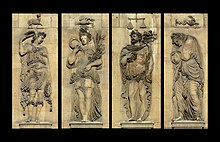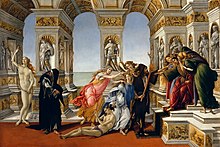
Personification is the representation of a thing or abstraction as a person. It is, in other words, considered an embodiment or an incarnation.[1] In the arts, many things are commonly personified. These include numerous types of places, especially cities, countries, and continents, elements of the natural world such as the trees or four seasons, four elements,[2] four cardinal winds, five senses,[3] and abstractions such as virtues, especially the four cardinal virtues and seven deadly sins,[4] the nine Muses,[5] or death.

In many polytheistic early religions, deities had a strong element of personification, suggested by descriptions such as "god of". In ancient Greek religion, and the related ancient Roman religion, this was perhaps especially strong, in particular among the minor deities.[6] Many such deities, such as the tyches or tutelary deities for major cities, survived the arrival of Christianity, now as symbolic personifications stripped of religious significance. An exception was the winged goddess of victory, Victoria/Nike, who developed into the visualisation of the Christian angel.[7]
Generally, personifications lack much in the way of narrative myths, although classical myth at least gave many of them parents among the major Olympian deities.[8] The iconography of several personifications "maintained a remarkable degree of continuity from late antiquity until the 18th century".[9] Female personifications tend to outnumber male ones,[10] at least until modern national personifications, many of which are male.

Personifications are very common elements in allegory, and historians and theorists of personification complain that the two have been too often confused, or discussion of them dominated by allegory. Single images of personifications tend to be titled as an "allegory", arguably incorrectly.[11] By the late 20th century personification seemed largely out of fashion, but the semi-personificatory superhero figures of many comic book series came in the 21st century to dominate popular cinema in a number of superhero film franchises.
According to Ernst Gombrich, "we tend to take it for granted rather than to ask questions about this extraordinary predominantly feminine population which greets us from the porches of cathedrals, crowds around our public monuments, marks our coins and our banknotes, and turns up in our cartoons and our posters; these females variously attired, of course, came to life on the medieval stage, they greeted the Prince on his entry into a city, they were invoked in innumerable speeches, they quarreled or embraced in endless epics where they struggled for the soul of the hero or set the action going, and when the medieval versifier went out on one fine spring morning and lay down on a grassy bank, one of these ladies rarely failed to appear to him in his sleep and to explain her own nature to him in any number of lines".[12]
- ^ "Definition of PERSONIFICATION". www.merriam-webster.com. 1 April 2024. Retrieved 4 April 2024.
- ^ Hall, 128–130
- ^ Hall, 122
- ^ Hall, 336–337
- ^ Hall, 216
- ^ Paxson, 6–7
- ^ Hall, 321
- ^ Hall, 216; the example here is the Muses, daughters of Apollo and Mnemosyne, herself the personification of Memory.
- ^ Hall, 128, speaking of the Four Seasons, but the same is true for example of the personification of Africa (same page).
- ^ Melion and Remakers, 5; Gombrich, 1 (of PDF)
- ^ Melion and Remakers, 2–13; Paxson, 5–6. See also Escobedo, Ch. 1
- ^ Gombrich, 1 (of PDF)